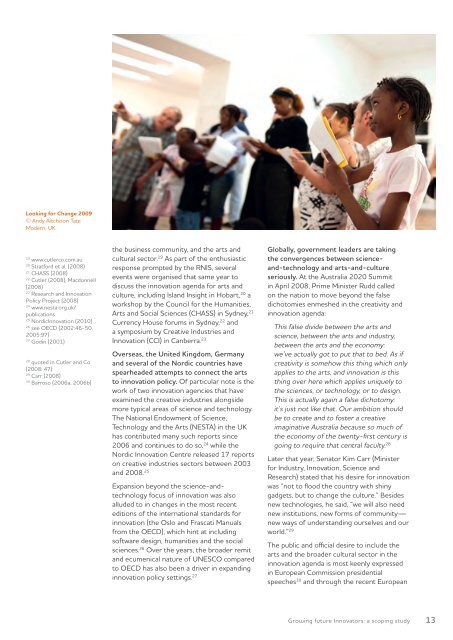GrowinG Future innovators - ARC Centre of Excellence for Creative ...
GrowinG Future innovators - ARC Centre of Excellence for Creative ...
GrowinG Future innovators - ARC Centre of Excellence for Creative ...
Create successful ePaper yourself
Turn your PDF publications into a flip-book with our unique Google optimized e-Paper software.
Looking <strong>for</strong> Change 2009<br />
© Andy Aitchison Tate<br />
Modern, UK<br />
19 www.cutlerco.com.au<br />
20 Strat<strong>for</strong>d et al. (2008)<br />
21 CHASS (2008)<br />
22 Cutler (2008), Macdonnell<br />
(2008)<br />
23 Research and Innovation<br />
Policy Project (2008)<br />
24 www.nesta.org.uk/<br />
publications<br />
25 NordicInnovation (2010)<br />
26 see OECD (2002:46-50,<br />
2005:97)<br />
27 Godin (2001)<br />
28 quoted in Cutler and Co<br />
(2008: 47)<br />
29 Carr (2008)<br />
30 Barroso (2006a, 2006b)<br />
the business community, and the arts and<br />
cultural sector. 19 As part <strong>of</strong> the enthusiastic<br />
response prompted by the RNIS, several<br />
events were organised that same year to<br />
discuss the innovation agenda <strong>for</strong> arts and<br />
culture, including Island Insight in Hobart, 20 a<br />
workshop by the Council <strong>for</strong> the Humanities,<br />
Arts and Social Sciences (CHASS) in Sydney, 21<br />
Currency House <strong>for</strong>ums in Sydney, 22 and<br />
a symposium by <strong>Creative</strong> Industries and<br />
Innovation (CCI) in Canberra. 23<br />
Overseas, the United Kingdom, Germany<br />
and several <strong>of</strong> the Nordic countries have<br />
spearheaded attempts to connect the arts<br />
to innovation policy. Of particular note is the<br />
work <strong>of</strong> two innovation agencies that have<br />
examined the creative industries alongside<br />
more typical areas <strong>of</strong> science and technology.<br />
The National Endowment <strong>of</strong> Science,<br />
Technology and the Arts (NESTA) in the UK<br />
has contributed many such reports since<br />
2006 and continues to do so, 24 while the<br />
Nordic Innovation <strong>Centre</strong> released 17 reports<br />
on creative industries sectors between 2003<br />
and 2008. 25<br />
Expansion beyond the science-andtechnology<br />
focus <strong>of</strong> innovation was also<br />
alluded to in changes in the most recent<br />
editions <strong>of</strong> the international standards <strong>for</strong><br />
innovation (the Oslo and Frascati Manuals<br />
from the OECD), which hint at including<br />
s<strong>of</strong>tware design, humanities and the social<br />
sciences. 26 Over the years, the broader remit<br />
and ecumenical nature <strong>of</strong> UNESCO compared<br />
to OECD has also been a driver in expanding<br />
innovation policy settings. 27<br />
Globally, government leaders are taking<br />
the convergences between scienceand-technology<br />
and arts-and-culture<br />
seriously. At the Australia 2020 Summit<br />
in April 2008, Prime Minister Rudd called<br />
on the nation to move beyond the false<br />
dichotomies enmeshed in the creativity and<br />
innovation agenda:<br />
This false divide between the arts and<br />
science, between the arts and industry,<br />
between the arts and the economy:<br />
we’ve actually got to put that to bed. As if<br />
creativity is somehow this thing which only<br />
applies to the arts, and innovation is this<br />
thing over here which applies uniquely to<br />
the sciences, or technology, or to design.<br />
This is actually again a false dichotomy:<br />
it’s just not like that. Our ambition should<br />
be to create and to foster a creative<br />
imaginative Australia because so much <strong>of</strong><br />
the economy <strong>of</strong> the twenty-first century is<br />
going to require that central faculty. 28<br />
Later that year, Senator Kim Carr (Minister<br />
<strong>for</strong> Industry, Innovation, Science and<br />
Research) stated that his desire <strong>for</strong> innovation<br />
was “not to flood the country with shiny<br />
gadgets, but to change the culture.” Besides<br />
new technologies, he said, “we will also need<br />
new institutions, new <strong>for</strong>ms <strong>of</strong> community—<br />
new ways <strong>of</strong> understanding ourselves and our<br />
world.” 29<br />
The public and <strong>of</strong>ficial desire to include the<br />
arts and the broader cultural sector in the<br />
innovation agenda is most keenly expressed<br />
in European Commission presidential<br />
speeches 30 and through the recent European<br />
Growing future Innovators: a scoping study 13




![Plebiscite (Riegert chapter) revised FINAL [Feb 14].pdf](https://img.yumpu.com/8710373/1/190x245/plebiscite-riegert-chapter-revised-final-feb-14pdf.jpg?quality=85)